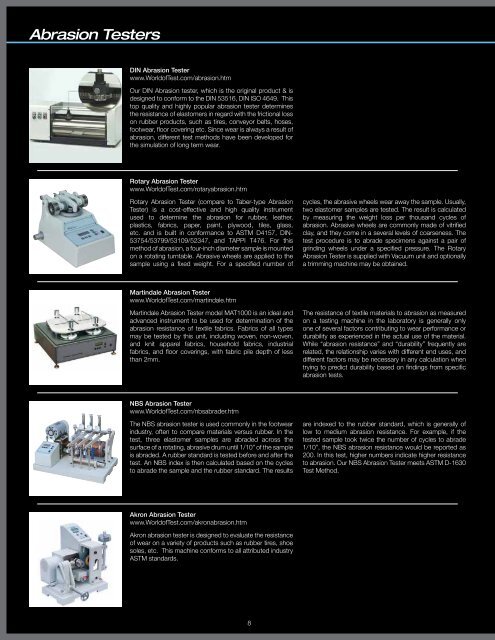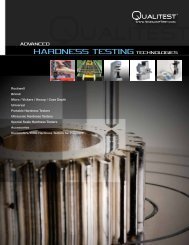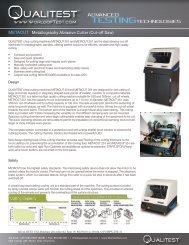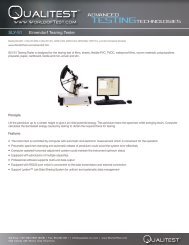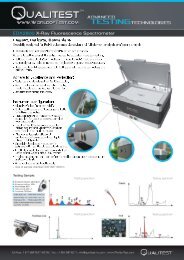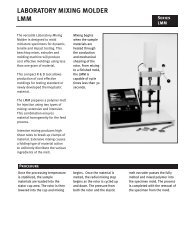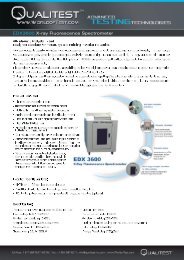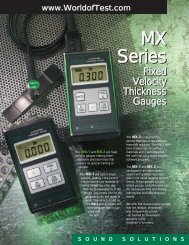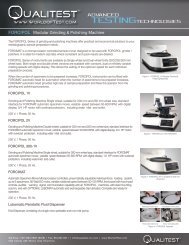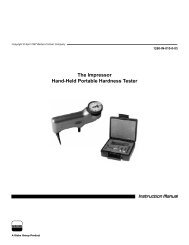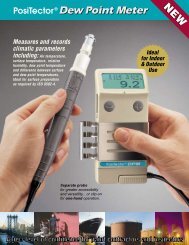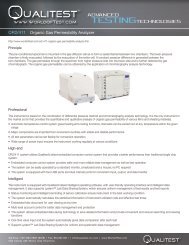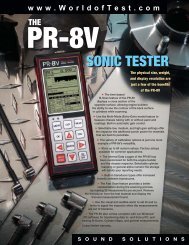Rubber Testing Technologies - QUALITEST â WorldofTest.com
Rubber Testing Technologies - QUALITEST â WorldofTest.com
Rubber Testing Technologies - QUALITEST â WorldofTest.com
You also want an ePaper? Increase the reach of your titles
YUMPU automatically turns print PDFs into web optimized ePapers that Google loves.
Abrasion Testers<br />
DIN Abrasion Tester<br />
www.<strong>WorldofTest</strong>.<strong>com</strong>/abrasion.htm<br />
Our DIN Abrasion tester, which is the original product & is<br />
designed to conform to the DIN 53516, DIN ISO 4649. This<br />
top quality and highly popular abrasion tester determines<br />
the resistance of elastomers in regard with the frictional loss<br />
on rubber products, such as tires, conveyor belts, hoses,<br />
footwear, floor covering etc. Since wear is always a result of<br />
abrasion, different test methods have been developed for<br />
the simulation of long term wear.<br />
Rotary Abrasion Tester<br />
www.<strong>WorldofTest</strong>.<strong>com</strong>/rotaryabrasion.htm<br />
Rotary Abrasion Tester (<strong>com</strong>pare to Taber-type Abrasion<br />
Tester) is a cost-effective and high quality instrument<br />
used to determine the abrasion for rubber, leather,<br />
plastics, fabrics, paper, paint, plywood, tiles, glass,<br />
etc. and is built in conformance to ASTM D4157, DIN-<br />
53754/53799/53109/52347, and TAPPI T476. For this<br />
method of abrasion, a four-inch diameter sample is mounted<br />
on a rotating turntable. Abrasive wheels are applied to the<br />
sample using a fixed weight. For a specified number of<br />
cycles, the abrasive wheels wear away the sample. Usually,<br />
two elastomer samples are tested. The result is calculated<br />
by measuring the weight loss per thousand cycles of<br />
abrasion. Abrasive wheels are <strong>com</strong>monly made of vitrified<br />
clay, and they <strong>com</strong>e in a several levels of coarseness. The<br />
test procedure is to abrade specimens against a pair of<br />
grinding wheels under a specified pressure. The Rotary<br />
Abrasion Tester is supplied with Vacuum unit and optionally<br />
a trimming machine may be obtained.<br />
Martindale Abrasion Tester<br />
www.<strong>WorldofTest</strong>.<strong>com</strong>/martindale.htm<br />
Martindale Abrasion Tester model MAT1000 is an ideal and<br />
advanced instrument to be used for determination of the<br />
abrasion resistance of textile fabrics. Fabrics of all types<br />
may be tested by this unit, including woven, non-woven,<br />
and knit apparel fabrics, household fabrics, industrial<br />
fabrics, and floor coverings, with fabric pile depth of less<br />
than 2mm.<br />
The resistance of textile materials to abrasion as measured<br />
on a testing machine in the laboratory is generally only<br />
one of several factors contributing to wear performance or<br />
durability as experienced in the actual use of the material.<br />
While “abrasion resistance” and “durability” frequently are<br />
related, the relationship varies with different end uses, and<br />
different factors may be necessary in any calculation when<br />
trying to predict durability based on findings from specific<br />
abrasion tests.<br />
NBS Abrasion Tester<br />
www.<strong>WorldofTest</strong>.<strong>com</strong>/nbsabrader.htm<br />
The NBS abrasion tester is used <strong>com</strong>monly in the footwear<br />
industry, often to <strong>com</strong>pare materials versus rubber. In the<br />
test, three elastomer samples are abraded across the<br />
surface of a rotating, abrasive drum until 1/10” of the sample<br />
is abraded. A rubber standard is tested before and after the<br />
test. An NBS index is then calculated based on the cycles<br />
to abrade the sample and the rubber standard. The results<br />
are indexed to the rubber standard, which is generally of<br />
low to medium abrasion resistance. For example, if the<br />
tested sample took twice the number of cycles to abrade<br />
1/10”, the NBS abrasion resistance would be reported as<br />
200. In this test, higher numbers indicate higher resistance<br />
to abrasion. Our NBS Abrasion Tester meets ASTM D-1630<br />
Test Method.<br />
Akron Abrasion Tester<br />
www.<strong>WorldofTest</strong>.<strong>com</strong>/akronabrasion.htm<br />
Akron abrasion tester is designed to evaluate the resistance<br />
of wear on a variety of products such as rubber tires, shoe<br />
soles, etc. This machine conforms to all attributed industry<br />
ASTM standards.<br />
8


